著名的四大音乐教学法资料讲解
四大音乐教学法心得体会
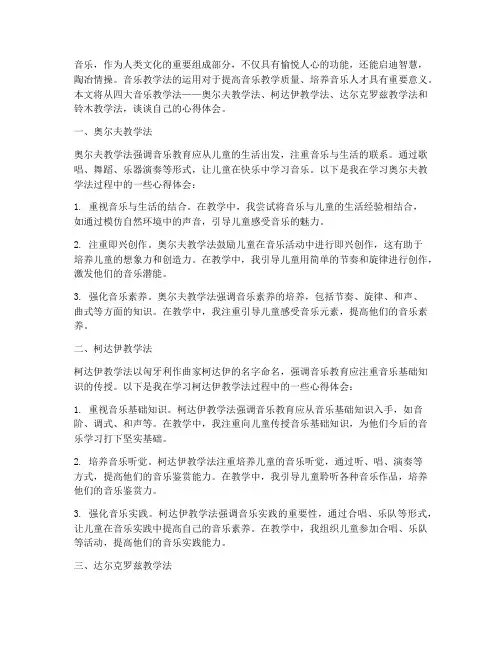
音乐,作为人类文化的重要组成部分,不仅具有愉悦人心的功能,还能启迪智慧,陶冶情操。
音乐教学法的运用对于提高音乐教学质量、培养音乐人才具有重要意义。
本文将从四大音乐教学法——奥尔夫教学法、柯达伊教学法、达尔克罗兹教学法和铃木教学法,谈谈自己的心得体会。
一、奥尔夫教学法奥尔夫教学法强调音乐教育应从儿童的生活出发,注重音乐与生活的联系。
通过歌唱、舞蹈、乐器演奏等形式,让儿童在快乐中学习音乐。
以下是我在学习奥尔夫教学法过程中的一些心得体会:1. 重视音乐与生活的结合。
在教学中,我尝试将音乐与儿童的生活经验相结合,如通过模仿自然环境中的声音,引导儿童感受音乐的魅力。
2. 注重即兴创作。
奥尔夫教学法鼓励儿童在音乐活动中进行即兴创作,这有助于培养儿童的想象力和创造力。
在教学中,我引导儿童用简单的节奏和旋律进行创作,激发他们的音乐潜能。
3. 强化音乐素养。
奥尔夫教学法强调音乐素养的培养,包括节奏、旋律、和声、曲式等方面的知识。
在教学中,我注重引导儿童感受音乐元素,提高他们的音乐素养。
二、柯达伊教学法柯达伊教学法以匈牙利作曲家柯达伊的名字命名,强调音乐教育应注重音乐基础知识的传授。
以下是我在学习柯达伊教学法过程中的一些心得体会:1. 重视音乐基础知识。
柯达伊教学法强调音乐教育应从音乐基础知识入手,如音阶、调式、和声等。
在教学中,我注重向儿童传授音乐基础知识,为他们今后的音乐学习打下坚实基础。
2. 培养音乐听觉。
柯达伊教学法注重培养儿童的音乐听觉,通过听、唱、演奏等方式,提高他们的音乐鉴赏能力。
在教学中,我引导儿童聆听各种音乐作品,培养他们的音乐鉴赏力。
3. 强化音乐实践。
柯达伊教学法强调音乐实践的重要性,通过合唱、乐队等形式,让儿童在音乐实践中提高自己的音乐素养。
在教学中,我组织儿童参加合唱、乐队等活动,提高他们的音乐实践能力。
三、达尔克罗兹教学法达尔克罗兹教学法以瑞士作曲家达尔克罗兹的名字命名,强调音乐教育应注重音乐表达和创造力的培养。
“四大音乐教学法”在学前教育课堂中的展开与应用
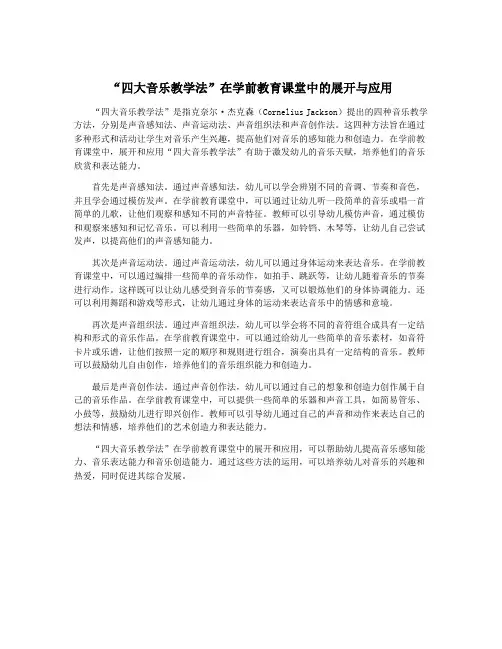
“四大音乐教学法”在学前教育课堂中的展开与应用“四大音乐教学法”是指克奈尔·杰克森(Cornelius Jackson)提出的四种音乐教学方法,分别是声音感知法、声音运动法、声音组织法和声音创作法。
这四种方法旨在通过多种形式和活动让学生对音乐产生兴趣,提高他们对音乐的感知能力和创造力。
在学前教育课堂中,展开和应用“四大音乐教学法”有助于激发幼儿的音乐天赋,培养他们的音乐欣赏和表达能力。
首先是声音感知法。
通过声音感知法,幼儿可以学会辨别不同的音调、节奏和音色,并且学会通过模仿发声。
在学前教育课堂中,可以通过让幼儿听一段简单的音乐或唱一首简单的儿歌,让他们观察和感知不同的声音特征。
教师可以引导幼儿模仿声音,通过模仿和观察来感知和记忆音乐。
可以利用一些简单的乐器,如铃铛、木琴等,让幼儿自己尝试发声,以提高他们的声音感知能力。
其次是声音运动法。
通过声音运动法,幼儿可以通过身体运动来表达音乐。
在学前教育课堂中,可以通过编排一些简单的音乐动作,如拍手、跳跃等,让幼儿随着音乐的节奏进行动作。
这样既可以让幼儿感受到音乐的节奏感,又可以锻炼他们的身体协调能力。
还可以利用舞蹈和游戏等形式,让幼儿通过身体的运动来表达音乐中的情感和意境。
再次是声音组织法。
通过声音组织法,幼儿可以学会将不同的音符组合成具有一定结构和形式的音乐作品。
在学前教育课堂中,可以通过给幼儿一些简单的音乐素材,如音符卡片或乐谱,让他们按照一定的顺序和规则进行组合,演奏出具有一定结构的音乐。
教师可以鼓励幼儿自由创作,培养他们的音乐组织能力和创造力。
最后是声音创作法。
通过声音创作法,幼儿可以通过自己的想象和创造力创作属于自己的音乐作品。
在学前教育课堂中,可以提供一些简单的乐器和声音工具,如简易管乐、小鼓等,鼓励幼儿进行即兴创作。
教师可以引导幼儿通过自己的声音和动作来表达自己的想法和情感,培养他们的艺术创造力和表达能力。
“四大音乐教学法”在学前教育课堂中的展开和应用,可以帮助幼儿提高音乐感知能力、音乐表达能力和音乐创造能力。
著名的四大音乐教学法资料
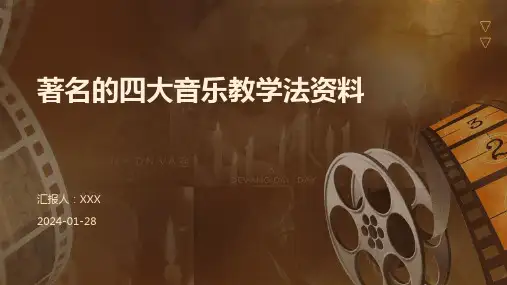
通过歌唱《小星星》并进行声势伴奏,让学生感受音乐的旋律和节奏 ,同时培养学生的歌唱能力和协调性。
打击乐器合奏
组织学生使用各种打击乐器进行合奏,培养学生的演奏技能和合作能 力,感受音乐的魅力和震撼力。
即兴创作表演
给定一个主题或场景,鼓励学生进行即兴创作表演,发挥学生的想象 力和创造力,培养学生的音乐创作能力和表现力。
歌唱与情感表达
达尔克罗兹音乐教学法注重歌唱训练,通过模仿和演唱不同风格的歌曲来培养学生的音乐表现力和情感表达能力 。例如,在课堂上老师会播放一首悲伤的歌曲并引导学生通过歌唱来表达内心的情感。学生可以运用不同的音色 、音量和演唱技巧来表达歌曲中的情感内涵从而更加深入地理解音乐的情感表达。
03
柯达伊音乐教学法
多声部合唱与合奏
柯达伊认为多声部合唱与合奏是音乐教育中重要的组成部分,能够培养学生的团队合作精 神和音乐表现能力。
实例分析
歌曲《五月的夜晚》
这首歌曲是柯达伊教学法中的经典曲目之一,通过这首歌 曲的教学,可以展示柯达伊教学法在节奏、音高和合唱方 面的训练方法和效果。
节奏练习《小鼓手》
这个节奏练习通过模仿小鼓手的节奏型,训练学生的节奏 感和协调性,体现了柯达伊教学法在节奏训练方面的特点 。
合唱作品《晚安,我的宝贝》
这首合唱作品展示了柯达伊教学法在多声部合唱方面的训 练成果,通过这首作品的教学,可以培养学生的团队合作 精神和音乐表现能力。
04
奥尔夫音乐教学法
基本原理与观点
原本性音乐教育
奥尔夫认为,音乐教育应该回归 到人原本具有的音乐本能,通过 综合性的音乐教育激发和培养学
生的创造力。
基本原理与观点
1 2 3
音乐教育是全民教育
著名的四大音乐教学法

案例分析与应用
01
匈牙利音乐教育体系
柯达伊教学法在匈牙利得到了广泛应用,形成了独具特色的匈牙利音乐
教育体系。该体系注重民族音乐文化的传承和发展,培养了大量优秀的
音乐人才。
02
国际音乐教育领域
柯达伊教学法在国际音乐教育领域也产生了重要影响。许多国家和地区
的音乐教育工作者都借鉴了柯达伊教学法的理念和方法,推动了当地音
综合性
奥尔夫音乐教学法强调音乐、舞蹈、戏剧等多种艺术形式的综合,让学生在全面、丰富的 艺术体验中感受音乐的魅力。
创造性
奥尔夫鼓励学生在音乐学习中发挥创造性,通过即兴创作、改编等方式表达自己的情感和 想法。
实施步骤与方法
01
02
03
04
节奏训练
通过拍手、跺脚、捻指等身体 动作进行节奏训练,培养学生
的节奏感。
案例二
在小学音乐课堂上,老师采用奥尔夫音乐教学法的理念, 让学生通过演奏乐器、歌唱、舞蹈等多种方式参与音乐活 动,提高他们的音乐素养和综合能力。
案例三
在音乐治疗领域,奥尔夫音乐教学法的原则也被广泛应用 。治疗师通过引导患者参与音乐活动,帮助他们缓解情绪 压力、改善心理状ห้องสมุดไป่ตู้。
CHAPTER 05
综合音乐感教学法
学生创作出自己的舞蹈或歌曲来表现这首歌曲。
应用
达尔克罗兹音乐教学法可以应用于各个年龄段的音乐教学,特别是儿童音乐教育。在儿 童音乐教育中,达尔克罗兹音乐教学法可以帮助儿童更好地感受和理解音乐,培养他们 的音乐兴趣和爱好,提高他们的音乐素养和审美能力。同时,达尔克罗兹音乐教学法也
可以应用于成人音乐教育,帮助成人更好地学习和掌握音乐技能。
融合后的音乐教学法将更加注重学生的个体差异和全面发 展,更加强调音乐教育的实践性和创新性。未来,这种融 合型的教学法将在音乐教育领域得到更广泛的应用和推广 。
音乐四大教学法实践教学(3篇)
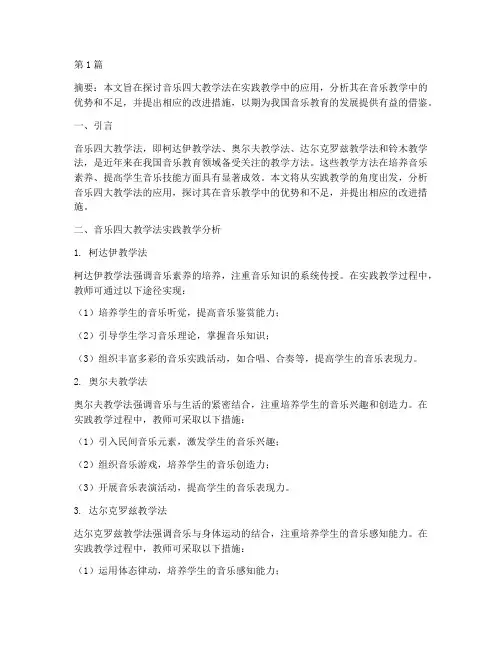
第1篇摘要:本文旨在探讨音乐四大教学法在实践教学中的应用,分析其在音乐教学中的优势和不足,并提出相应的改进措施,以期为我国音乐教育的发展提供有益的借鉴。
一、引言音乐四大教学法,即柯达伊教学法、奥尔夫教学法、达尔克罗兹教学法和铃木教学法,是近年来在我国音乐教育领域备受关注的教学方法。
这些教学方法在培养音乐素养、提高学生音乐技能方面具有显著成效。
本文将从实践教学的角度出发,分析音乐四大教学法的应用,探讨其在音乐教学中的优势和不足,并提出相应的改进措施。
二、音乐四大教学法实践教学分析1. 柯达伊教学法柯达伊教学法强调音乐素养的培养,注重音乐知识的系统传授。
在实践教学过程中,教师可通过以下途径实现:(1)培养学生的音乐听觉,提高音乐鉴赏能力;(2)引导学生学习音乐理论,掌握音乐知识;(3)组织丰富多彩的音乐实践活动,如合唱、合奏等,提高学生的音乐表现力。
2. 奥尔夫教学法奥尔夫教学法强调音乐与生活的紧密结合,注重培养学生的音乐兴趣和创造力。
在实践教学过程中,教师可采取以下措施:(1)引入民间音乐元素,激发学生的音乐兴趣;(2)组织音乐游戏,培养学生的音乐创造力;(3)开展音乐表演活动,提高学生的音乐表现力。
3. 达尔克罗兹教学法达尔克罗兹教学法强调音乐与身体运动的结合,注重培养学生的音乐感知能力。
在实践教学过程中,教师可采取以下措施:(1)运用体态律动,培养学生的音乐感知能力;(2)组织音乐游戏,提高学生的音乐表现力;(3)引导学生参与音乐创作,培养学生的音乐创造力。
4. 铃木教学法铃木教学法强调音乐教育的重要性,注重培养学生的音乐素养。
在实践教学过程中,教师可采取以下措施:(1)传授音乐知识,提高学生的音乐素养;(2)组织音乐实践活动,培养学生的音乐表现力;(3)注重学生的个体差异,因材施教。
三、音乐四大教学法实践教学的优势与不足1. 优势(1)提高学生的音乐素养,培养音乐兴趣;(2)培养学生的音乐技能,提高音乐表现力;(3)注重学生的个体差异,因材施教;(4)教学方法丰富多样,有利于激发学生的学习兴趣。
“四大音乐教学法”在学前教育课堂中的展开与应用
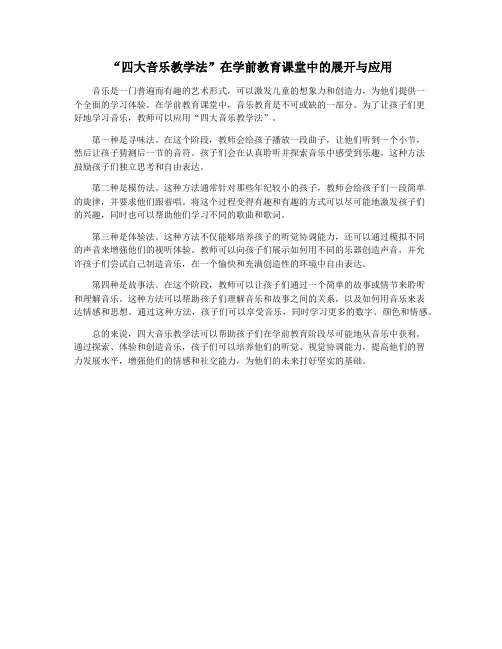
“四大音乐教学法”在学前教育课堂中的展开与应用音乐是一门普遍而有趣的艺术形式,可以激发儿童的想象力和创造力,为他们提供一个全面的学习体验。
在学前教育课堂中,音乐教育是不可或缺的一部分。
为了让孩子们更好地学习音乐,教师可以应用“四大音乐教学法”。
第一种是寻味法。
在这个阶段,教师会给孩子播放一段曲子,让他们听到一个小节,然后让孩子猜测后一节的音符。
孩子们会在认真聆听并探索音乐中感受到乐趣。
这种方法鼓励孩子们独立思考和自由表达。
第二种是模仿法。
这种方法通常针对那些年纪较小的孩子,教师会给孩子们一段简单的旋律,并要求他们跟着唱。
将这个过程变得有趣和有趣的方式可以尽可能地激发孩子们的兴趣,同时也可以帮助他们学习不同的歌曲和歌词。
第三种是体验法。
这种方法不仅能够培养孩子的听觉协调能力,还可以通过模拟不同的声音来增强他们的视听体验。
教师可以向孩子们展示如何用不同的乐器创造声音,并允许孩子们尝试自己制造音乐,在一个愉快和充满创造性的环境中自由表达。
第四种是故事法。
在这个阶段,教师可以让孩子们通过一个简单的故事或情节来聆听和理解音乐。
这种方法可以帮助孩子们理解音乐和故事之间的关系,以及如何用音乐来表达情感和思想。
通过这种方法,孩子们可以享受音乐,同时学习更多的数字、颜色和情感。
总的来说,四大音乐教学法可以帮助孩子们在学前教育阶段尽可能地从音乐中获利。
通过探索、体验和创造音乐,孩子们可以培养他们的听觉、视觉协调能力,提高他们的智力发展水平,增强他们的情感和社交能力,为他们的未来打好坚实的基础。
著名的四大音乐教学法(Fourfamousmusicteachingmethods)
著名的四大音乐教学法(Four famous music teaching methods)Four famous music teaching methodsFirst, the Roman law teaching method:Content overview:One of the four major music teaching methods in the world is teacher's music pedagogy, which is characterized by the improvisation of piano lessons, and the students' experience of music with body movements. Ross's teaching method is in Swiss musician, educator, composer and conductor, dancer and poet in a Emil. Jack's rswstone (Emile Jaques - Dalcroze, 1865-1950) on 1905 at the Geneva Academy of music and the successful experiment in Shidi teaching method. The teaching methods are as follows: 1. rhythm teaching, 2. listening training, 3. improvisation.1. rhythm teaching: This is the body's most natural rhythm for the body, to express the response to the rhythm of the music. This teaching mode is used in our kindergarten, elementary school, the rhythm of music.... It is often with body movements such as walking, running, stoop: action to represent the beat; or by clapping, foot to distinguish different notes; or by game rhythm to stimulate students' ability to respond to the rhythm... This ability to play the basic ability of learning music with the sense of rhythm of the limbs can be regarded as one of the most comprehensive, cognitive and reflective music teaching.2. listening training: Mike Roche as movable do training taught to sing songs, listening to music or memory is helpful to ability, especially the interval between cognition,simple songs like singing, must be with the rhythm of the body in order to achieve the "inner hearing ability" music education.3. improvisation, by any instrument playing, students can freely play creative dance movements to speculate on the motives and artistic conception of music. On the other hand. Ross also encourages the creation and try on the melody and harmony, he believes that with the rhythm is not negligent.The teaching characteristics of Roche pedagogy:1., pay attention to the rhythm of children's rhythm and music teaching.2. dance and rhythm are the main activities of music teaching.3., the teaching materials should be taken from the rhythm of the material in nature, which is the most natural feeling for children's music learning.4. attaches great importance to children's "visual" and "auditory" feel ability training.5., improvisational dance performance can promote children's ability to express themselves.6., music teaching should be based on rhythm teaching.Two, Gao Dayi teaching method:Content overview:According to Gao's view, he believes that human voice is the best teaching tool. Singing must be unaccompanied, just like traditional folk songs. From this point of view, the implementation of music teaching, with well-trained teachers and complete teaching materials, both in the urban villages, even the most remote areas, can be implemented; and its teaching object by two year old children and adults, can sing through the way of learning music, it is the national music education ideal.Gao Dayi's teaching method can use the singing teaching method as its teaching aim. It advocates all music activities include: 1. singing teaching, 2. rhythm coordination teaching, 3. Solfeggio and song practice, and 4. sign language teaching.1. singing teachingChildhood singing to listen and sing sing has been read "imitation" songs, proverbs and folk rhymes of life as the theme, from the three degree interval began singing, and five tone scale range, select the appropriate teaching materials with the implementation of teaching, adopt progressive teaching methods from two sections to the four section, and then expanded to eight to twelve bar phrases, each class in 20 minutes for the principle.2. rhythm coordination Teaching(1) begin with a quick and slow rhythm of the feeling, listen to the rhythm of the teacher, and then imitate yourself by clapping or stepping.(2) rhythm teaching method is adopted to implement rhythm teaching.(3) use the songs to cooperate with the game, especially for children to have the opportunity to create designs to cope with the dance movements of singing.3. Solfeggio and song practiceThe song and Gao Dayi have a series of textbooks, most from the folk, as the level of the students and give appropriate teaching materials. The training in the sol FA sing songs to practice exercises spectrum; two part chorus, mostly ballads, with five tone scale mode, the rhythm is more difficult, for a higher degree of ability of Solfeggio and songs drills.4. sign language teachingApplication of the teaching method of John Gao Dayi S Curwen to assist the sign language, the main feature is the use of visual, with skill plus sign, to enhance children understand the scale of each kind of music, sound level interval distance between the relationship and the children can feel the children singing tune the expression of ups and downs.Gao Dayi, teaching method, teaching characteristics:1. teaching methods based on singing.2. take traditional folk songs and nursery rhymes as the mainteaching materials.3. the use of movable do and mobile Do singing, implementation of visual spectrum education.4. as the basis of the five tone scale.FiveThe British John S Curwen gesture teaching method is used to assist Solfeggio Teaching and to recognize the concept of pronunciation and sound.6. use rhythm syllable method to help rhythm cognition and so on.7. expose children to famous works in the world.8. lines of single spectrum import staff training.9., pay attention to listening attentively to the music of silent listening practice.Three, Orford teaching methodContent overviewOrford's basic idea of children's music teaching method is better than understanding. In the process of growth of young children, they in the natural environment, through instinct activities such as: imitation, touch, taste, physical activity,after slowly growth, make some subconscious experience to be a specific action, the expression of language become mature and to learn basic music ability. That is, from sense to concrete concept to language expression to reading writing stage to creation stage.(1) rhythmic teachingOrford as the key to the rhythm of music teaching learning activities, from simple, a foot, knee, tongue shot sound or hands beat action, to beat a single shot from the beginning, the natural rhythm of the speed, and then gradually to fast rhythm, and import to the pace of learning mode.(two) music teaching activitiesRhythm language is one of the basic teaching activities to enter the melody. Children are familiar with the spoken, nursery rhymes, games and chants in their lives... As the singing of the textbook, from words to words and even sentences, by imitation, repeated practice let the students experience the feeling of music, and to understand the basic elements of music, including regular rhythm, rhythm, sound level changes into ideas and practice in mode, by the instrument and the preliminary concept of chord.The song sing the rhythm of language teaching in vocabulary along driven, rhythm, extended to phrase exercises, plus body rhythm, the creation of dance movements, and cultivate the full expression of the feeling of the music.(three) the teaching of rhythmic instrumentsIn order to improve children's interest in learning, the designer must design a set of rhythm instruments for students to practice. The content of the textbooks should be taken from the folk ballad of this country.Rhythm is to practice, ostinato accompaniment, form a five degree sound accompaniment is a melody and accompaniment to the tonic dominant mode, and according to the different tonal, commonly used instruments are xylophone, vibraphone, guitar, recorder, etc..... Is one of the focus of teaching and improvisation, started playing bass teaching stubborn students are free, with the creation of the contract by the simple tune tonality, melody, the canon canonic way. Coupled with percussion accompaniment, so that students learn to be happy and have a sense of accomplishment.Orff, music teaching method, teaching method, characteristic1. use folk music as a teaching material.2., "rhythm" and "improvisation" as the teaching basis.3., in order to say the language, rhythm, familiar nursery rhymes, folk songs and games, it is a comprehensive teaching mode designed by rhythm instruments.By 4., Canon and pedale ostinato chorus makes a preliminary introduction and practice.5., pay attention to imitate singing and imitate the performance of teaching mode.6. use the function of clapping as the basic exercise of rhythm.In the 7. phrase as a unit as a rhythmic improvisation.Four 、 SUZUKI town teaching methodContent overviewSUZUKI pedagogy is a mother tongue teaching method, which emphasizes the development of children's potential from childhood.When children are born down at the age of two or three, the house began to shape the music scene, often put some elegant songs, stimulate the children feel the music ability. At that time, mother played an important role, often singing with children, or making simple clapping or body swinging with musical rhythm. At the age of three, children are allowed to watch and integrate into the game of music, while mothers teach their children, arrange regular exercises for their children, and set up a good practice environment. When he was four years old, he was in touch with musical instruments. SUZUKI taught violin as a teaching instrument. The main purpose was to train children's concentration and keen listening training. Each stage of the exercise is to continuously and repeatedly memorizing music. Fixed a week in addition to individual extracurricular, every week or two but also the first ensemble class, each other to learn from each other, learn from each other. Mainly to givechildren a sense of accomplishment, and increase children's confidence and ambition, and parents should continue to encourage and appreciate the children's practice, and establish a good family atmosphere.This persistent practice, observation, performances to teenagers and adults, although not a set everyone is a musician, but everyone can play to their potential and high professional standards.Suzuki Jinchi, teaching method, teaching characteristics1. create an environment for learning music and develop a good sense of music from it2. stresses the importance of imitation and repetition3. pay attention to the interaction between parents and children4., pay attention to the quality of timbre5. request the correctness of playing6. pay attention to acting or actingSevenSelf study ability of self-evaluation and peer observation8. encourage play on the back9. master the class time10. pay attention to group and individual classesThe above four teaching methods are often used nowadays. It is not difficult to find the "children centered" potential teaching method to stimulate children's imagination, creativity and concentration.。
享誉世界的四大音乐教学体系
享誉世界的四大音乐教学体系2013-2-21一、奥尔夫教学----器乐教学法卡尔-奥尔夫(Carl Orff1895-1982)是德国当代杰出的作曲家、音乐教育家。
其教学法主要内容是节奏、旋律练习,基本形体动作教学。
核心理念是:一切从儿童出发;通过亲身实践,主动学习。
其强调体验音乐应该包括体验所有的艺术,如:语言、歌唱、乐器、舞蹈、美术、戏剧等。
透过这些表现,去"探索""发挥"个人潜力及创造力。
与其它教学法,奥尔夫教学活动中节奏乐器的应用是其特色,故有器乐教学之称。
佐尔丹-柯达伊(Zoltan Kodaly1882-1967)匈牙利著名作曲家、民族音乐家、音乐教育家。
其教学法主要内容是首调唱名法、柯尔文手势、节奏唱名、节奏和唱名的简记法。
柯达伊教学法的目标和任务是:1、有意识地培养学生掌握民族的音乐母语;2、唤起儿童对唱歌的兴趣;3、培养和指导学生的音乐爱好;4、发展学生的音乐能力;5、培养以民间歌曲为基础的音乐的读写能力。
由于其学习音乐的各种要素如:节奏、旋律、乐理、音乐欣赏等,都是透过歌唱的活动,故高大宜音乐教学法有歌唱教学法之称。
三、日本---铃木教学法铃木镇一著名日本音乐教育家、小提琴教育家。
始终强调教育的主要目的是培养人。
主要以打击乐为主,结合多种音乐形式,以戏剧、故事为主要创作作品,提倡关注幼儿的音乐素养的培育以及对孩子健全人格的培养和提高为源动力。
他主张要“尊重孩子”,珍惜生命这一大自然所赋予的美好的力量,注意培养直觉或灵感的能力,以生命为中心去观察事物领悟艺术。
四、达克罗兹音乐教学法----律动教学法达尔克罗兹(EmileJaques Dalcroze 1865-1950)瑞士日内瓦音乐学院教授。
其教学法主要内容是体态律动、视唱练耳和即兴音乐活动。
基本原则是要培训学生感知音乐和反应音乐的能力,发展其内在音乐感觉,以及身体各部分进行迅速交流的能力、大量地储存听觉和动觉意向的能力。
“四大音乐教学法”在学前教育课堂中的展开与应用
“四大音乐教学法”在学前教育课堂中的展开与应用音乐是学前教育中非常重要的一门课程,能够培养幼儿的艺术素养、感受力和创造力,同时也能够提高幼儿对世界的认知和语言表达能力。
为了让幼儿更好地学习音乐,展开丰富多彩的音乐教学活动,教师们需要选择适合的音乐教学法。
目前,四大音乐教学法已经成为幼儿音乐教育中非常常用的一种方法,本文将从活动式教学法、感受式教学法、游戏式教学法和体验式教学法四个层面来探讨四大音乐教学法在学前教育课堂中的展开与应用。
一、活动式教学法活动式教学法是让幼儿通过各种游戏、律动活动来感受音乐,学习音乐知识。
例如,采用齐唱、合唱以及打节奏等教学方式,让幼儿们亲身体验到音乐的魅力,增强了他们对音乐的兴趣和学习的积极性。
除此之外,教师还可以组织各种音乐活动,例如快乐歌唱、音乐游戏等。
在快乐歌唱的过程中,可以通过唱歌来让幼儿了解不同的旋律和歌词,提高他们的歌唱技巧。
在音乐游戏中,可以通过组织游戏来让幼儿了解音乐知识,例如利用乐器、音乐盒等道具,来让幼儿认识不同的音乐乐器,了解乐器的发声原理等。
感受式教学法是让幼儿通过感受音乐的情感表达来加深对音乐的认识。
教师可以选用富有感染力的音乐作为教学素材,让幼儿通过感受音乐中蕴含的情感和意象来学习音乐。
例如,教师可以引导幼儿用各种形式表达听到的曲子所给他们带来的情感,如幸福、悲伤、愉悦等,让幼儿通过自己的语言、表情或肢体语言来表达对音乐的感受。
通过这种方式,不仅能够帮助幼儿感受到音乐的情感内涵,也能够提升幼儿的情感表达能力。
游戏式教学法是利用游戏和角色扮演等方式,来吸引幼儿的注意力,让幼儿通过游戏的活动来学习音乐。
例如,将角色扮演游戏、排队游戏、手势游戏等与音乐相结合来教学。
在排队游戏中,教师将幼儿分成若干小组,每组下楼梯时要跟着音乐节奏的快慢排队下来,这样既培养了幼儿的节奏感和央视音乐文艺节目快乐颂,又增强了幼儿的协作意识。
在手势游戏中,老师可以根据不同的音乐节奏,设计出不同的手势动作,然后通过这些手势动作来让幼儿模拟着音乐的节奏来对接,来掌握音乐旋律。
音乐四大教学法
一、达尔克洛兹教学法:内容概述:“达克罗士音乐教学法”为世界四大音乐教学法之一,其特色为教师以钢琴即兴方式教学,学生则以身体律动来体验对音乐的感受。
达克罗士教学法是瑞士集音乐家、教育家、作曲家、指挥家、舞蹈家及诗人于一身的艾弥尔.杰克-达克罗士(Emile Jaques - Dalcroze , 1865-1950)于1905年在日内瓦音乐院实验成功而公诸于世旳教学法。
其教学方式有:1.律动教学 2.听音训练 3.即兴创作。
1.律动教学:这是藉着身替肢体最自然的律动,表达对音乐节奏的反应。
这种教学模式常用在我们幼稚园、国小低年级的韵律、唱游…。
它经常以肢体的动作:如走步、跑步、弯腰动作来代表拍子;或藉着拍手、脚踏来分辨不同的音符;或藉着游戏的规律节奏来激发学生对节奏的反应能力…这种以肢体的节奏感,导引学习音乐基本能力的潜能发挥可说是最府合认知、思考的一种音乐教学。
2.听音训练:达克罗士认为以首调唱名来训练歌曲教唱,对于音乐欣赏的听音或记忆较有助益于能力的发挥,尤其音程间的认知,简单歌曲的仿唱,一定要配合身体的律动以达到「内在听觉感受能力」的音乐薰陶。
3. 即兴创作藉着任何乐器的弹奏,学生可以自由发挥创意性的舞蹈动作来揣测音乐的动机及意境。
另ㄧ方面达克罗士也鼓励对旋律与和声方面的创作与尝试,他认为节奏、韵律的配合是不能疏忽的。
达克罗氏教学法教学特性:1. 重视以儿童之体律动的节奏配合音乐教学。
2. 舞蹈与律动为音乐教学的主要活动。
3. 教材应取之于自然界中的节奏素材,是儿童音乐学习最自然的感受。
4. 非常重视儿童对「视觉」、「听觉」感受能力的培养。
5. 即兴的舞蹈表演动作可促进儿童的表达能力。
6. 音乐教学应以节奏教学做为基础。
二、柯达伊教学法:内容概述:根据高大宜的看法,他认为人声是最好的教学工具。
唱歌必须是无伴奏的,就像传统的民谣演唱一样。
由这个观点来看,音乐教学的实施,祇要具备接受良好训练的师资和完整的教材,则无论在都市乡镇,甚或最偏远的地区,都可以实施;而且它的教学对象由二岁的幼儿至成年人,都可以透过歌唱的方式来学习音乐,可说是最理想的全民音乐教育。
- 1、下载文档前请自行甄别文档内容的完整性,平台不提供额外的编辑、内容补充、找答案等附加服务。
- 2、"仅部分预览"的文档,不可在线预览部分如存在完整性等问题,可反馈申请退款(可完整预览的文档不适用该条件!)。
- 3、如文档侵犯您的权益,请联系客服反馈,我们会尽快为您处理(人工客服工作时间:9:00-18:30)。
著名的四大音乐教学
法
最著名的四大音乐教学法
一、达克罗士教学法:
内容概述:“达克罗士音乐教学法”为世界四大音乐教学法之一,其特色为教师以钢琴即兴方式教学,学生则以身体律动来体验对音乐的感受。
达克罗士教学法是瑞士集音乐家、教育家、作曲家、指挥家、舞蹈家及诗人于一身的艾弥尔.杰克-达克罗士(Emile Jaques - Dalcroze, 1865-1950)于1905年在日内瓦音乐院实验成功而公诸于世旳教学法。
其教学方式有:1.律动教学 2.听音训练 3.即兴创作。
1.律动教学:这是藉着身替肢体最自然的律动,表达对音乐节奏的反应。
这种教学模式常用在我们幼稚园、国小低年级的韵律、唱游…。
它经常以肢体的动作:如走步、跑步、弯腰动作来代表拍子;或藉着拍手、脚踏来分辨不同的音符;或藉着游戏的规律节奏来激发学生对节奏的反应能力…这种以肢体的节奏感,导引学习音乐基本能力的潜能发挥可说是最符合认知、思考的一种音乐教学。
2.听音训练:达克罗士认为以首调唱名来训练歌曲教唱,对于音乐欣赏的听音或记忆较有助益于能力的发挥,尤其音程间的认知,简单歌曲的仿唱,一定要配合身体的律动以达到「内在听觉感受能力」的音乐熏陶3. 即兴创作:这是藉着任何乐器的弹奏,学生可以自由发挥创意性的舞蹈动作来揣测音乐的动机及意境。
另一方面达克罗士也鼓励对旋律与和声方面的创作与尝试,他认为节奏、韵律的配合是不能疏忽的。
达克罗氏教学法教学特性:
1. 重视以儿童之体律动的节奏配合音乐教学。
2. 舞蹈与律动为音乐教学的主要活动。
3. 教材应取之于自然界中的节奏素材,是儿童音乐学习最自然的感受。
4. 非常重视儿童对「视觉」、「听觉」感受能力的培养。
5. 即兴的舞蹈表演动作可促进儿童的表达能力。
6. 音乐教学应以节奏教学作为基础。
二、高大宜教学法:
内容概述:根据高大宜的看法,他认为人声是最好的教学工具。
唱歌必须是无伴奏的,就像传统的民谣演唱一样。
由这个观点来看,音乐教学的实施,祇要具备接受良好训练的师资和完整的教材,则无论在都市乡镇,甚或最偏远的地区,都可以实施;而且它的教学对象由二岁的幼儿至成年人,都可以透过歌唱的方式来学习音乐,可说是最理想的全民音乐教育。
高大宜的教学法可以用歌唱教学法作为其教学宗旨其主张所有音乐活动有:1.歌唱教学、2.节奏的配合教学、3.视唱与歌曲练习、4.手语教学。
1. 歌唱教学幼儿时期的歌唱以听唱仿唱为主开始已『念』歌方式,用童谣民歌与生活之谚语作为题材,从小三度音程开始教唱,并以五声音阶的音域为主,选择适当的教材配合实施教学,采渐进的教学方式,由两小节到四小节,再扩大为八至十二小节的乐句,每次上课以20分钟为原则。
2. 节奏的配合教学(1)先以感觉节奏的快、慢开始,聆听老师的节奏示范再加上以自己模仿,以拍手或踏步方式实施。
(2)采用节奏音节念法实施节奏教学。
(3)以歌曲配合游戏动作,尤其让儿童有创造设计的机会以配合唱歌的舞蹈动作。
3. 视唱与歌曲练习高大宜的歌曲与视唱有一系列的教本,大部份取之于民谣,视学生程度而给予适当的教材。
视唱训练多以首调唱名法唱谱练习;歌曲练习则以二声部合唱为主,多为民谣,采用五声音阶的调式,节奏较难,适合程度较高的能力者视唱及歌曲演练。
4. 手语教学高大宜的应用John S Curwen的手语以辅助视唱的教学法,主要的特点是利用视觉,加上身手配合的手语动作,来加深儿童聊解音阶中,各音之间的音程高低的距离关系并使儿童能感受儿童歌唱时曲调所表达起伏的那种音乐性。
高大宜教学法教学特性:1. 以歌唱为主的教学法。
2. 以传统民谣、儿歌作为主要教材。
3. 运用首调唱名及移动Do唱法,实施视谱教育。
4. 以五声音阶作为基础。
5. 引用英国John S Curwen手势教学法,辅助视唱教学,辨识音与音之间的高低观念。
6. 使用节奏音节念法帮助节奏的认知等。
7. 让儿童接触到世界上着名的作品。
8. 使用条线的独谱方式导入五线谱的训练。
9. 注重用心听音乐的静默听音练习。
三、奥福教学法
内容概述奥福对于儿童音乐教学法的基本理念在「感觉」优于「理解」。
在幼童的生长过程中,他们在最自然环境中,透过本能的活动如:模仿、触觉、味觉、肢体的活动,经过慢慢的成长,使一些潜意识的经验成为具体的行动,加上语言日见成熟的表达去学习音乐基本能力。
也就是由感觉→具体概念→语言表达→读写→到创作的阶段。
(一)节奏教学奥福教学以节奏为音乐学习活动的重点,从简单的弹指、踏脚、拍膝、舌头声或双手击拍动作,以单拍子的一拍一拍开始,从自然的律动速度,再渐进到快速节奏,并导入要学习的节奏模式。
(二)唱游活动教学节奏语言是进入曲调的基本教学活动之一,儿童藉着生活中所接触耳熟能详的说白、童谣、游戏、吟诵…作为歌唱的教材,由单字到词汇甚至到句子,由模仿,一再重复练习让学生体会音乐的感受,进而了解音乐的基本要素,包括规律性的节奏、变化节奏、音成高低的观念以及轮唱模式的练习,经由乐器的伴奏而有初步的合弦概念。
歌曲的教唱先由节奏语言的带动,依字汇顺着节奏,延伸到乐句的练习,加上肢体的韵律,创作出舞蹈的动作,充分表达对音乐的感受与陶冶。
(三)节奏乐器的教学为提高儿童学习的兴趣,教学者必须设计一套节奏乐器给学生练习,教材内容应取自本国民谣。
节奏乐器的练习,是以顽固低音为伴奏,形式采用五度合音伴奏,也就是用一个曲调的主音与属音为伴奏的模式,可按调性的不同而移动,常用的乐器有木琴、铁琴、直笛、吉他等…。
而即兴创作也是教学重点之一,刚开始教学者弹奏顽固低音,学生可自由创作配合同调性之曲调,由简单的曲调,采用卡农轮唱的方式。
加上敲击伴奏,使学生学的快乐且学的有成就感。
奥尔夫音乐教学法教法特性:
1. 以各国民谣作为教材。
2. 以「节奏」与「即兴创作」作为教学基础。
3. 以说白语言节奏、熟悉的儿歌、民谣、游戏配合节奏乐器所设计的一种综合性的教学模式。
4. 藉持续低音、卡农及顽固低音作初步合声的介绍与练习。
5. 注重模仿演唱及模仿演奏的教学模式。
6. 运用拍手的功能作为节奏的基本练习。
7. 以乐句为单位作为节奏的即兴练习。
四、铃木镇教学法
内容概述铃木教学法可说是一种母语教学法,从小即着重儿童潜力的发挥。
当孩童生下来两三岁间,家里就开始塑造音乐情境,常放一些优雅的歌曲,刺激孩子对音乐的感受能力。
在那时母亲扮演很重要的角色,时常带着孩子仿唱,或以音乐的节奏做简单的拍手或身体摇摆的游戏。
三岁时则让孩子观摩融入音乐的游戏课程,母亲则要指导孩子,安排孩子规律性的练习时间,并布置很好的练习环境。
四岁时则正式接触乐器,铃木教学法以小提琴为教学乐器最主,主要训练孩子专心程度的培养以及敏锐的听力训练。
每阶段的练习都要不断的反覆、熟记谱子。
每周除了固定上个别课外,每一周或两周还要上ㄧ次合奏课,彼此互相观摩,互相学习。
主要要给孩子有成就感,并增加孩子的信心与上进心,而父母要不断的鼓励与欣赏孩子的练习,建立良好的家庭气氛。
这样持续性的练习、观摩、表演一直到青少年以至成人,虽然不ㄧ定每一个人都是音乐家,但每一个人却都能发挥其潜能且都具有专业的水准。
铃木镇一教学法教学特色1. 创造学习音乐的环境,并从中培养良好的音乐感2. 强调模仿和反覆练习的重要性3. 注重父母与孩子的互动4. 注重音色的品质5. 要求弹奏的正确性6. 注重表演或演出7. 重视自我评量和同侪观摩的自学能力8. 鼓励背谱弹奏9. 掌握上课时间10. 团体课与个别课并重.以上四大教教学法是目前常被采用
的,不难发现是以儿童为中心的潜能教学法,激发儿童的想像力、创造力与专专注力。
